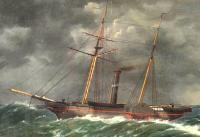 In 1970, fisherman discovered a shipwreck in about 85 feet of water, ten miles off the Absecon Inlet on the New Jersey coast. For more than 40 years, divers have visited the unidentified wreck. Now the National Oceanic and Atmospheric Administration (NOAA) has positively identified the wreck as the iron-hulled side-wheel steamer, Robert J. Walker, a U.S. Coast Survey vessel that sank in 1860 after a violent collision with a 250-ton schooner. Twenty sailors aboard the Walker died, making it the worst accident in the history of the U.S. Coast Survey or its successor, NOAA.
In 1970, fisherman discovered a shipwreck in about 85 feet of water, ten miles off the Absecon Inlet on the New Jersey coast. For more than 40 years, divers have visited the unidentified wreck. Now the National Oceanic and Atmospheric Administration (NOAA) has positively identified the wreck as the iron-hulled side-wheel steamer, Robert J. Walker, a U.S. Coast Survey vessel that sank in 1860 after a violent collision with a 250-ton schooner. Twenty sailors aboard the Walker died, making it the worst accident in the history of the U.S. Coast Survey or its successor, NOAA.
NOAA says shipwreck off southern NJ coast is steamer that sank in 1860, killing 20 sailors
James Delgado, director of maritime heritage for NOAA’s office of national marine sanctuaries …said the Walker could be one of the last remaining shipwrecks to be identified off the New Jersey coast. According to NOAA, the ship’s unique engines and rectangular portholes were key identifying features. It was still pointed toward Absecon lighthouse, where it likely was trying to head before it sank.
Built in 1847, the Walker did survey work charting the waters of the southern United States and contributed to the opening up of many ports on the Gulf Coast to increased commerce, according to NOAA. Its work also helped chart harbors that would become strategically important for the Union Navy in the looming Civil War.
On the night of June 21, 1860, the Walker was heading north to New York when it collided with the schooner Fanny, headed from Philadelphia to Boston. In a newspaper interview, the ship’s quartermaster described the scene as the steamer sank within about 30 minutes.
“The men stayed by the steamer until she was sinking, and then, without confusion, such of them as could took to the boats,” Charles Clifford told the New York Herald. “Many of the crew went down with the steamer, however, clinging to the spars and portions of the wreck. … The captain stayed on board until the steamer went down, and just before she disappeared from sight jumped into the water, and was picked up by one of the boats.”
Thanks to Walter Stevens, Phil Leon, Irwin Bryan and Brian Frissel for contributing to this post.
